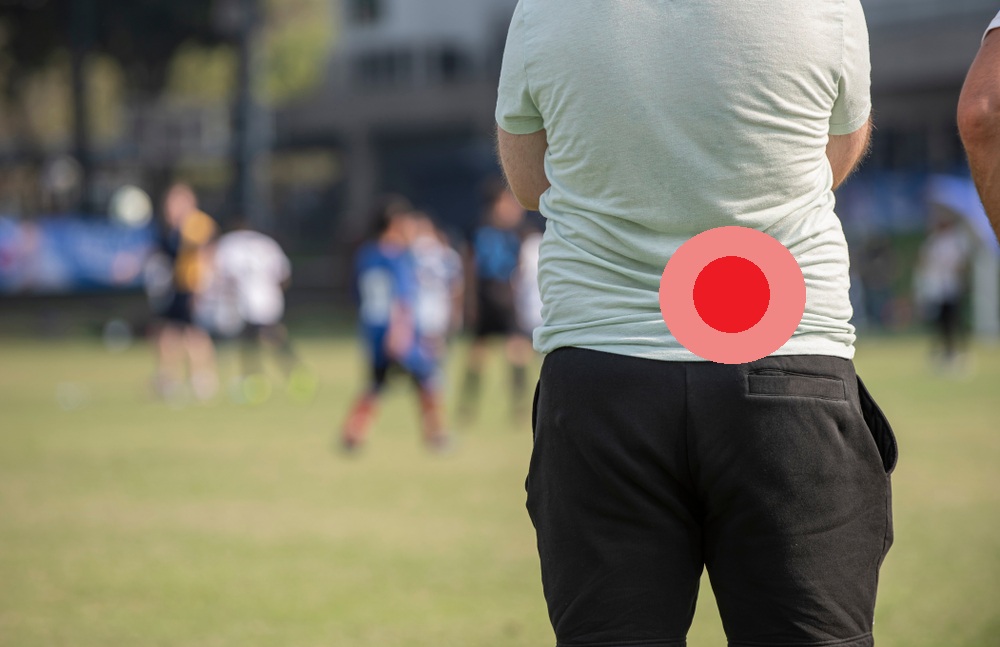Why Does Our Lower Back Ache When Standing Still?

It’s easy to think of a time when prolonged standing led to discomfort. Chatting to clients over the last few months, lower back pain has come up several times and we were discussing how it can occur when you are:
- Waiting in line at theme parks to get on a ride.
- Enjoying your favourite band at a gig.
- Watching from the sideline as your children play sport.
- Cooking or washing up for long periods.
- Standing during a commute to work.
- Attending social events such as weddings or birthday parties.
- Working, some jobs require you to stand for long periods such as working in a shop or hairdressing.
The main culprit is not a particularly serious issue, but it is annoying and can often distract you from enjoying yourself or relaxing. The issue often lies in muscle fatigue and postural stress. So, why does this happen?
Why Standing Still Causes Pain
Standing still puts your back muscles and spine under constant pressure to maintain an upright position, leading to muscle fatigue. Movement helps distribute the load across different muscle groups and promotes better blood flow, reducing strain on any one area, however, it’s not always possible to do when you are at an event. Generally speaking, poor posture in that moment, weaker core muscles and even unsupportive footwear can contribute to the ache.
How to Ease or Prevent the Pain
To ease or prevent lower back pain, you can shift your weight regularly by alternating between feet or standing and sitting when possible. By lightly engaging your abdominal muscles you can support your lower back, while gentle stretches or movements like bending forward, twisting side-to-side, or walking provide relief.
Comfortable and supportive footwear, combined with strengthening exercises like planks, bird dogs, or pelvic tilts, can reduce discomfort. Maintaining good posture by keeping your shoulders relaxed, your spine neutral and avoiding locking your knees is essential. Using props like a small step to rest one foot at a time, as well as applying a warm compress or massaging the area, can also help.
7 Core Exercises to Support Your Back
A strong core is essential, not just for alleviating and preventing lower back pain or ache, but also to encourage good posture. Here are some exercises to try at home:
- Planks involve engaging your core and maintaining a straight body line, if you wish to vary this exercise, why not try side or forearm planks.
- Bird dogs (or Superman) improve balance and stability by extending one arm and the opposite leg while on all fours.
- Pelvic tilts, lay on you back andstart by flattening your lower back against the floor, then tilt your pelvis upward. If you practice Pilates this could then lead into the bridge exercise.
- Glute bridges a build on the pelvic tilt exercise for controlled core engagement. Lay on your back, then slowly lift your pelvis and hips off the floor while engaging your glutes and core. For greater intensity, raise one leg towards the ceiling and alternate. If your hamstrings cramp, don’t forget to stretch and go back to the gentle lift.
- Dead bugs strengthen your core, start by lying on your back with your knees bent and arms raised, then slowly lower one arm and the opposite leg, repeat.
- Russian twists are a great one to build that tummy muscle. Start by sitting on the floor with your knees bent, then twist from side-to-side, keen to increase the intensity? Then why not try holding a weight.
- Mountain climbers, a personal favourite of mine they are a great way of combining core strength and cardio. Start by leaning forward onto a sofa or chair, this should be slightly raised, go into a plank position, then pull up alternate knees towards your chest.
Repeat the above 10-12 times each in set and repeat for three sets. Nearly all these exercises can be found in a Pilates class, so if you are looking for a stronger core, a 1:2:1 session or classes are a great place to start.
This month from 12-18 May, it is Mental Health Awareness Week and this year the theme is around “Community”. The Mental Health Awareness Week | Mental Health Foundation. say that:
“Being part of a safe, positive community is vital for our mental health and wellbeing. We thrive when we have strong connections with other people and supportive communities that remind us, we are not alone”.
Not only can movement also help with our mental wellbeing but Pilates classes, running groups and group exercise classes are a great way to meet people and build that sense of community. Please get in touch to chat more about how I can help you achieve your movement goals.
